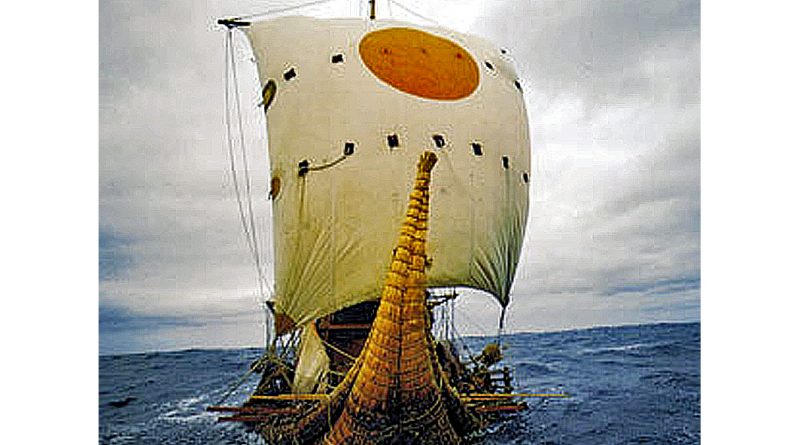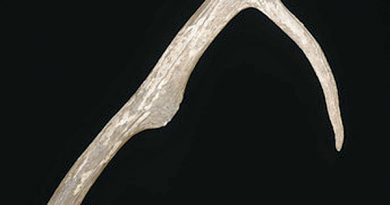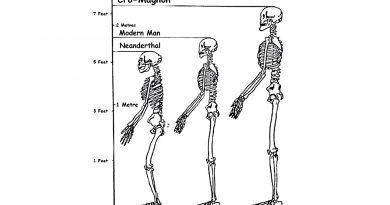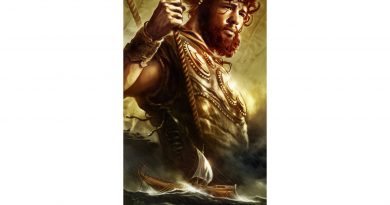Who was the first European to reach America – the bones and tools suggest it was in prehistory and not Columbus?
“We would like to live as we once lived, but history will not permit it” – John F. Kennedy
A blood type (also called a blood group) is a classification of blood based on the presence or absence of inherited antigenic substances on the surface of red blood cells (RBCs). These antigens may be proteins, carbohydrates, glycoproteins, or glycolipids depending on the blood group system. Some of these antigens are also present on the surface of other types of cells of various tissues. Several red blood cell surface antigens can stem from one allele (or very closely linked genes) and collectively form a blood group system. Blood types are inherited and represent contributions from both parents. A total of 32 human blood group systems are now recognised by the International Society of Blood Transfusion (ISBT). The two most important ones are ABO and the RhD antigen; they determine someone’s blood type (A, B, AB and O, with + and – denoting RhD status).
Many pregnant women carry a fetus with a blood type different from their own, and the mother can form antibodies against fetal RBCs. Sometimes these maternal antibodies are IgG, a small immunoglobulin, which can cross the placenta and cause haemolysis of fetal RBCs, leading to the newborn’s haemolytic disease called erythroblastosis fetalis of low fetal blood counts that ranges from mild to severe. Sometimes this is lethal for the fetus; in these cases, it is called hydrops fetalis.
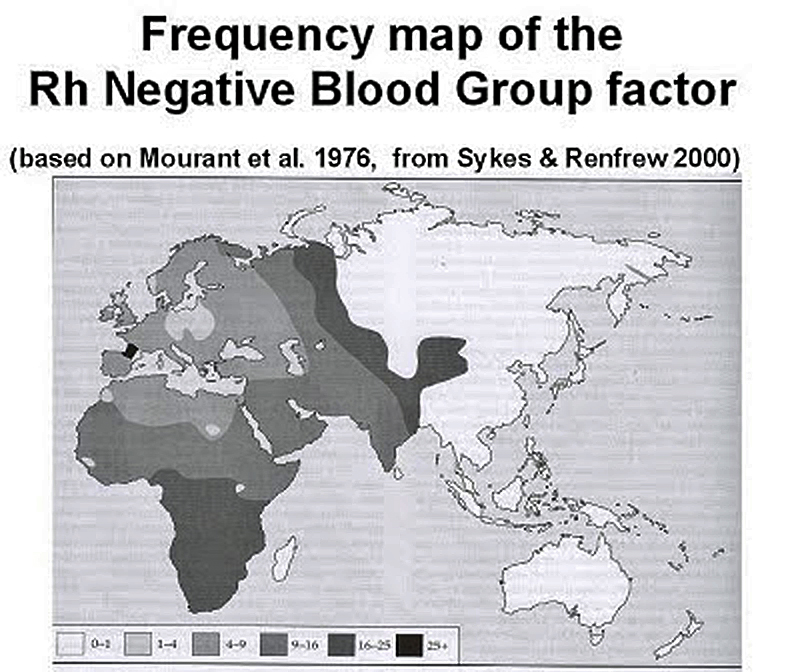
One of the Greatest Mysteries in Anthropology is how the A Rh neg blood groups originated in North America.
Blood groups are an excellent method to detect population migration in conjunction with modern DNA Haplogroups, as the former has been identified for over 100 years, unlike the contemporary techniques.
An individual either has or does not have the ‘Rhesus factor’ on the surface of their red blood cells. This term strictly refers only to the most immunogenic D antigen of the Rh blood group system or the Rh- blood group system. Rh-positive usually indicates the status (Rh+ does have the D antigen) or Rh negative (Rh- does not have the D antigen) suffix to the ABO blood type.
Our History books tell us…
According to the New World migration model, a migration of humans from Eurasia to the Americas took place via Beringia, a land bridge that connected the two continents across what is now the Bering Strait. However, the most recent point at which this migration could have taken place, where the first Americans set foot on Alaska, is 40,000 – 12,000 years ago, a hotly disputed topic.
Traditional distribution of ‘Walking’ humans in time
The early ‘stone age’ Paleo-Indians spread throughout the Americas, diversifying into hundreds of culturally distinct nations and tribes. According to the oral histories of many indigenous peoples of the Americas, they have been living there since their genesis, described by a wide range of traditional creation accounts.
While some indigenous peoples of the Americas were historically hunter-gatherers, many practised aquaculture and agriculture. The impact of their agricultural endowment to the world is a testament to their time and work in reshaping and cultivating the flora indigenous to the Americas. Some societies depended heavily on agriculture, while others practised a mix of farming, hunting, and gathering. In some regions, the indigenous peoples created monumental architecture, large-scale organised cities, chiefdoms, states, and empires.
Indigenous Americans still populate many Americas; some countries have sizeable populations, especially Bolivia, Peru, Mexico, Guatemala, Colombia, and Ecuador. At least a thousand different indigenous languages are spoken in the Americas. Some count their speakers in millions, such as Quechua, Aymara, Guaraní, Mayan, and Nahuatl. Many also maintain indigenous cultural practices to varying degrees, including religion, social organisation and subsistence practices. Nevertheless, some indigenous peoples still lived in relative isolation from Western society, and a few are still unconnected peoples.

According to wiki:
About 40,000 years ago, Homo Sapiens walked across the land bridge of Alaska and entered America, finally going south to they reached South America all sharing the same blood type ‘O’, but then a second wave came across in 12,000 BP (Before present) and brought the Blood type A, B and AB with them and settled only in North America.
But there is a massive problem with this theory – apart from who in their right mind would walk across a footbridge for over a thousand years to a cold and inhospitable place (Alaska)?
The Na-Dené, Inuit and Indigenous Alaskan populations exhibit haplogroup Q (Y-DNA); however, they are distinct from other indigenous Amerindians with various mtDNA and atDNA mutations. This suggests that the peoples who first settled the northern extremes of North America and Greenland derived from later migrant populations than those who penetrated further south in the Americas. Linguists and biologists have reached a similar conclusion based on analysis of Amerindian language groups and ABO blood group system distributions.
On the East Coast of Asia (at the start of the footbridge), there is less than 4% Rh Neg blood, 90% of the blood is ‘O’ type Rh-positive – 6% A,B or AB Rh-positive. So, if travellers who took the ‘land bridge across’ their descendants disappeared into extinction, they never left a trace of interbreeding with the local peoples, even though they walked this pathway for thousands of years – not one stopped to settle or cohabited with the local population.
However, the Haplogroup Q (Y-DNA) shows apparent migration from America to Asia and not vice-versa.
Moreover, the indigenous American Blackfoot Indians of North America are 82% A blood group RH Negative- the other 18% are probably an example of interbreeding since modern Europeans conquered them and their footprint stretches from the lakes of the east coast but falls short of the American West Coast or Alaska.
Where did these ‘indigenous’ people come from?
If we look at a map of the northern hemisphere, we will see a high frequency of the Rh neg bloodline is in Spain, Ireland, Scotland, Faroe Islands, Iceland, Greenland and Eastern Canada moving West down the East Coast of North America to Central America. This is because in 10 000 BCE, the sea levels were much lower and The Northern Atlantic looked a lot different than today, as the Sea Levels were 160m Lower and the landmasses such as Faroe, Iceland and Greenland were much more extensive than the present, allowing easy passage across the Atlantic to America, for any society who had the possession of sea boats.
There is substantial evidence that reed boats were constructed on the shorelines of the Caspian Sea since about 40,000 BP, which are depicted on the caves that would have overlooked the Post Glacial Flooded waters – which is nowadays about a mile from the present Caspian Sea shoreline. These types of reed boats would have achieved sea travel as shown in the 1970s by Thor Heyerdahl (October 6, 1914 – April 18, 2002) was a Norwegian ethnographer and adventurer with a background in biology, zoology, botany, and geography.
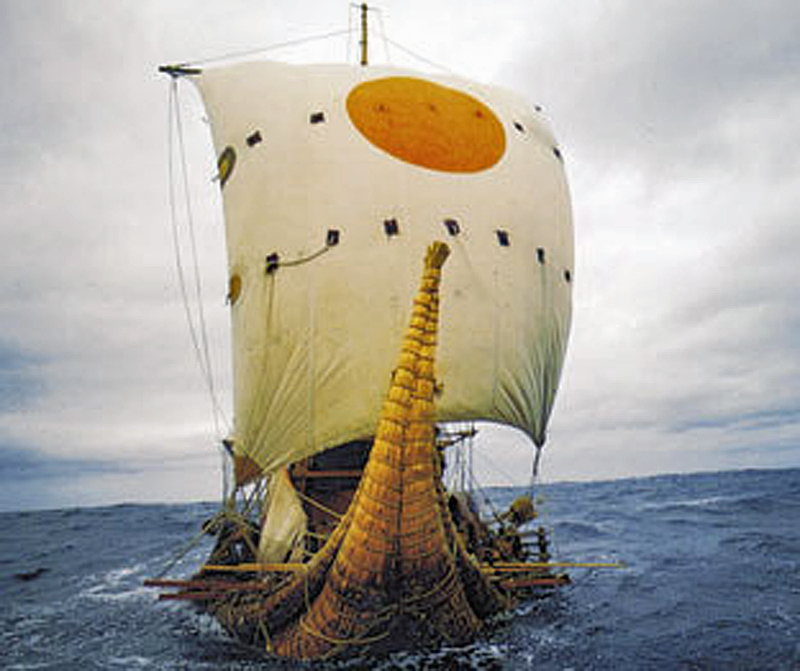
He became notable for his Kon-Tiki expedition in 1947, in which he sailed 8,000 km (5,000 mi) across the Pacific Ocean in a hand-built raft from South America to the Tuamotu Islands. The expedition was designed to demonstrate that ancient people could have made long sea voyages, creating contacts between apparently separate cultures. This was linked to a diffusion model of cultural development. Heyerdahl subsequently made other voyages designed to demonstrate the possibility of communication between widely separated ancient peoples.
In 1969 and 1970, Heyerdahl built two boats from papyrus and attempted to cross the Atlantic Ocean from Morocco in Africa. Based on drawings and models from ancient Egypt, the first boat, named Ra (after the Egyptian Sun god), was constructed by boat builders from Lake Chad using papyrus reed obtained from Lake Tana in Ethiopia and launched into the Atlantic Ocean from the coast of Morocco. The Ra crew included Thor Heyerdahl (Norway), Norman Baker (USA), Carlo Mauri (Italy), Yuri Senkevich (USSR), Santiago Genoves (Mexico), Georges Sourial (Egypt) and Abdullah Djibrine (Chad).
Only Heyerdahl and Baker had sailing and navigation experiences. After several weeks, Ra took on water after its crew modified the vessel, causing it to sag and break apart after sailing more than 4000 miles. The crew was forced to abandon Ra some hundred miles before Caribbean islands and was saved by a yacht.
The following year, 1970, another similar vessel, Ra II, was built of totara by Demetrio, Juan and Jose Limachi from Lake Titicaca in Bolivia and likewise set sail across the Atlantic from Morocco, this time with great success.
The voyage around the northern islands is simple but challenging due to extensive cloud cover. However, using a Sunstone device, this difficulty can easily be overcome. A Sunstone is a device that allows navigators to follow the sun (indicating the sun’s direction) when it is daytime but cloudy. This device was known to be used as far back as the Viking societies, and as it was a ‘natural’ discovery, there is no reason that the use of the stone could not go further back in history.
Who were the first Europeans to find America?
It was formerly thought by palaeontologists that Neanderthal morphed into Cro-Magnon and that Cro-Magnon was the progenitor of human beings as we know them today. However, aside from the problems of the Eve Hypothesis, there are severe problems with the assumptions about when modern human types appeared on Earth. Even if we take the evolving scientific view of the present day, we find that Cro-Magnon man was something altogether different from other anatomically modern humans.
Over and over again, we read in scientific studies that Cro-Magnon man was just an “anatomically modern human.” The experts will say: “The Cro-Magnons lived in Europe between 35,000 and 10,000 years ago. They are virtually identical to modern man, tall and muscular and slightly more robust than most modern humans.”
Notice how they slip in that “slightly more robust” bit.
The fact is, the Cro-Magnon man was, compared to the other’ anatomically modern humans’ around him, practically a superman. They were skilled hunters, toolmakers and artists famous for the cave art at Lascaux, Chauvet, and Altamira. According to anthropologists, “they had a high cranium, a broad and upright face, and cranial capacity – about the same as modern humans (can we say larger?), but less than that of Neanderthals. The males were as tall as 6 feet.”
They appeared in Europe in the upper Pleistocene about 40,000 years ago, and “their geographic origin is still unknown.” However, the DNA and colouring of Neanderthals indicate that they were Red Haired and Blue-eyed, unlike their Homo Sapien Cousins, who was dark-haired and brown-eyed.
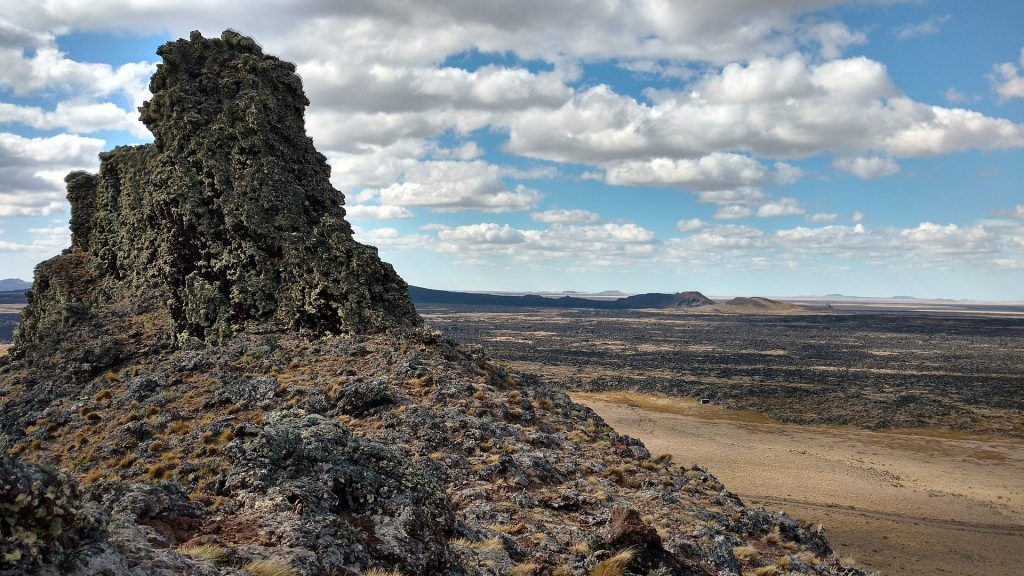
Their skeletal remains show a “few small differences from modern humans.” But, of course, the “out of Africa” theory advocates suggest that Cro-Magnon came from Sub Saharan Africa and a temperate climate and that “they would eventually adapt to all extremes of heat and cold.” In this way, the “slight differences” between Cro-Magnon and other forms of anatomically modern humans can be explained away as an adaptation to the cold.
Moreover, Cro-Magnon’s have been found with Rh-Negative Blood (Cavalli-Sforza, L. Luca; Menozzi, Paolo; Alberto, Piazza (1994). The History and Geography of Human Genes)
A skeleton estimated as being 10,000 years old was found in the ‘tomb of Palli Aike’ in Tierra del Fuego in 1969-70 and has been identified as Cro-Magnon, which indicates that this race also spread to South America. It is now believed that Neanderthal man as the proto-European, and Cro-Magnon (a hybrid mutation) a later arrival, probably from the West. It is also thought that Cro-Magnons has many similarities to the North American Indians, being tall, muscular, athletic and agile.
Dr James C. Chatters, a University of Washington’s specialist in human osteology, while investigating what was initially thought to be a modern homicide, found himself analysing the bones of a 9,000-year-old skeleton. Upon examination, the 5 feet 9 inches tall specimen had characteristics that are similar to those of Europeans” (Chatters, 2000). According to Chatters, the skull is dolichocranic (long-headed) rather than brachycranic (round-headed) and exhibits “fairly prominent brow ridges.” Now known as Kennewick Man, this skeleton possesses many of the characteristics of our typical Atlantean Cro-Magnons.
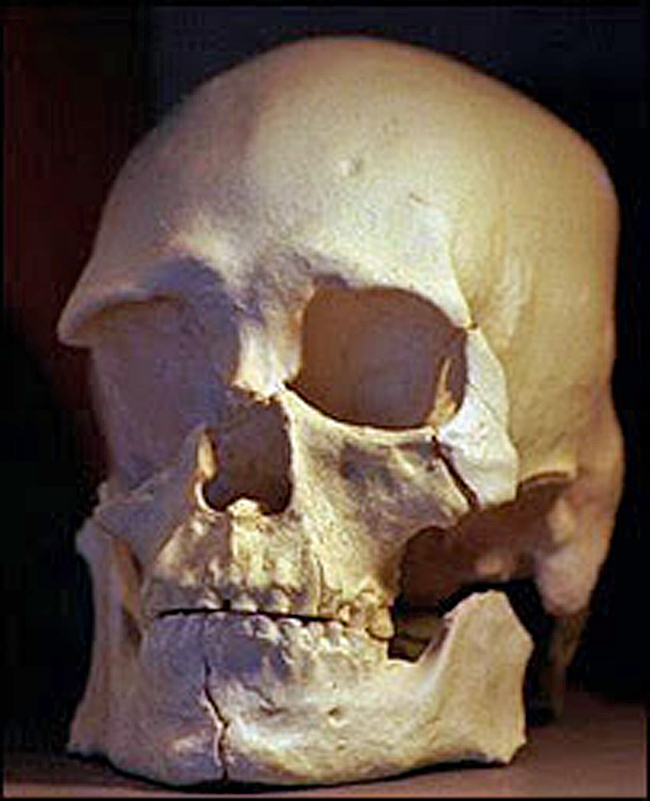
Poverty Point culture 8000 – 7000 BP is not well understood in terms of social organisation; it was involved in the transportation of non-local raw materials (for example, shell, stone, and copper) from throughout the eastern United States into the lower Mississippi River Valley to selected sites where the materials were worked into finished products and then traded. While specific information on Poverty Point subsistence, trade mechanisms, and other cultural aspects is still speculative, the sites, nevertheless, exhibit distinctive material culture, such as baked clay objects, magnetite plummets, steatite bowls, red jasper lapidary work, fibre-tempered pottery, and microlithic stone tools – which is a clear indication of European Cro-Magnon influence.
Dr Dennis Stanford of the Smithsonian Museum of Natural History in Washington states: “We now know that human beings learned to sail 50,000 years before the present. Humanity settled in Australia then, and any land bridge did not link it to Asia. It could only have been reached by boat. We had mastered sailing tens of thousands of years before America was colonised, so we should not be surprised by the idea that people took boat trips across the Atlantic 18,000 years ago” (Stanford & Bradley, 2004)
Dr Tom D. Dillehay (1999) of the University of Kentucky writes: “It is likely that people arrived in the Southern Hemisphere no later than 15,000 to 14,000 years ago.” One such site has been excavated at Monte Verde, Chile, 500 miles south of Santiago. First, evidence was gathered and carefully analysed over the last two decades by a team of American and Chilean archaeologists led by Dillehay. Then, early in 2006, a group of archaeologists, including several of Monte Verde’s most rigorous critics, visited the site and inspected the artefacts, coming away totally convinced.
Thirty years ago, experts in American Archeology would not admit to man’s presence anywhere on the continents of North and South America earlier than 12,000 years ago as it would have changed the world’s known history.
During a class in European Prehistoric Archaeology at the University of Oklahoma under Dr Robert Bell, let slip to his class that he participated in an essential dig at Sandia Cave near Albuquerque, NM. However, the lower occupation level was dated at 27,000 BC (Hibben, 1941). However, the experts refused to recognise it (Haynes & Agonino, 1986; Preston, 1995, et al.).

In his report of the site visit, Dr Alex W. Barker, chief curator of the Dallas Museum of Natural History, said: “While there were very strongly voiced disagreements about different points, it rapidly became clear that everyone was in fundamental agreement about the most important question of all. Monte Verde is real. It’s old. And it’s a whole new ball game.” according to Michael B. Collins of the University of Texas at Austin, Monte Verde is “a bona fide archaeological assemblage, it is very old, and it has profound implications for American prehistory” (Collins, 1999).
For more information about British Prehistory and other articles/books, go to our BLOG WEBSITE for daily updates or our VIDEO CHANNEL for interactive media and documentaries. The TRILOGY of books that ‘changed history’ can be found with chapter extracts at DAWN OF THE LOST CIVILISATION, THE STONEHENGE ENIGMA and THE POST-GLACIAL FLOODING HYPOTHESIS. Other associated books are also available such as 13 THINGS THAT DON’T MAKE SENSE IN HISTORY and other ‘short’ budget priced books can be found on our AUTHOR SITE. For active discussion on the findings of the TRILOGY and recent LiDAR investigations that is published on our WEBSITE you can join our FACEBOOK GROUP.

